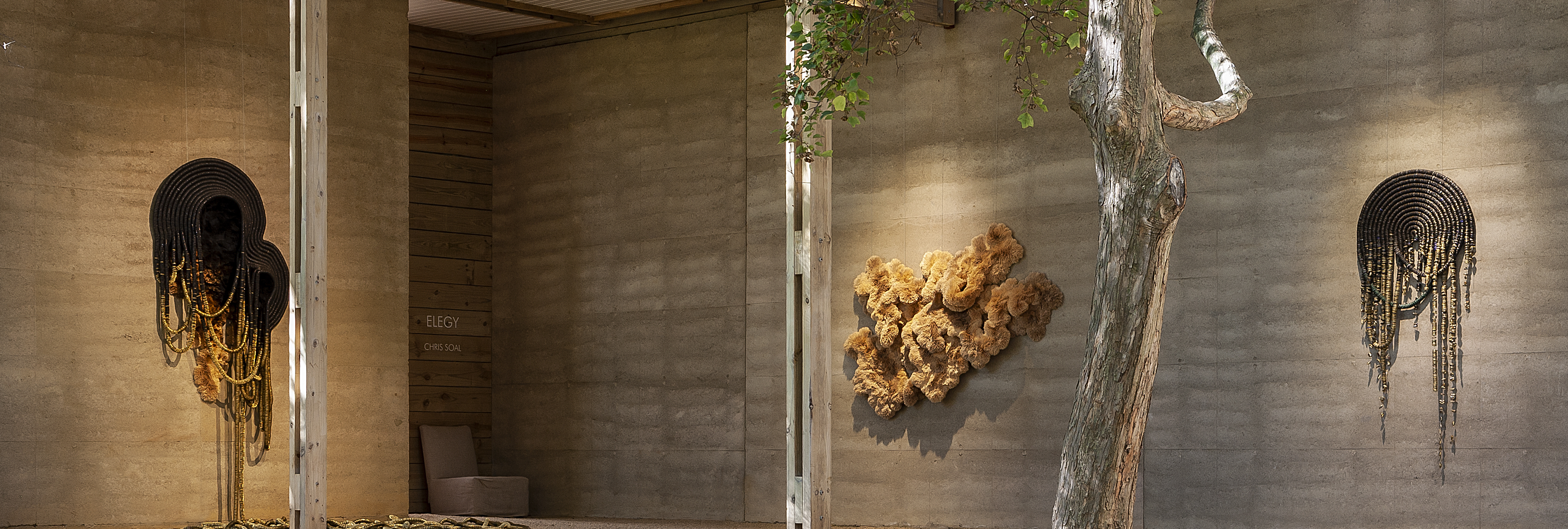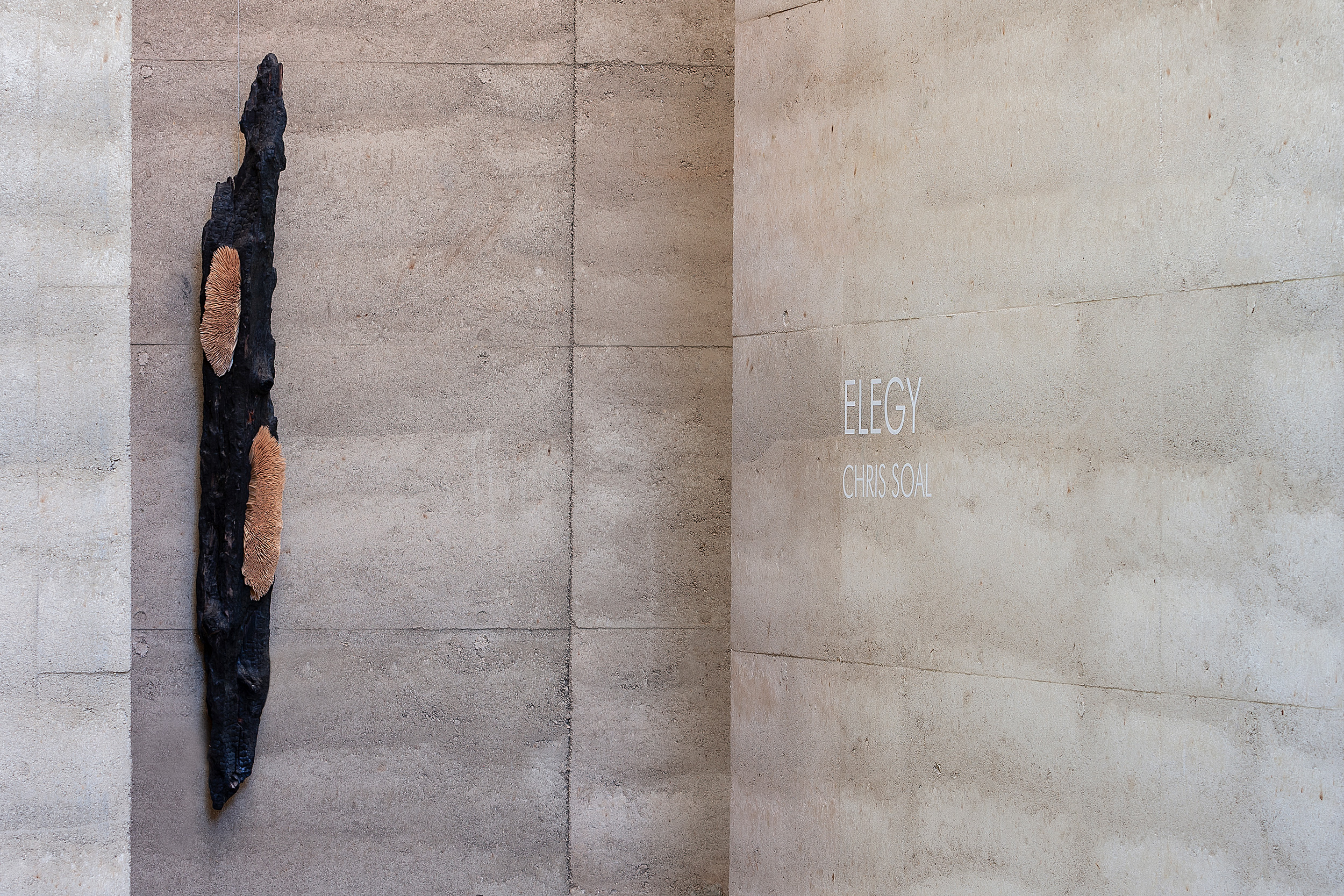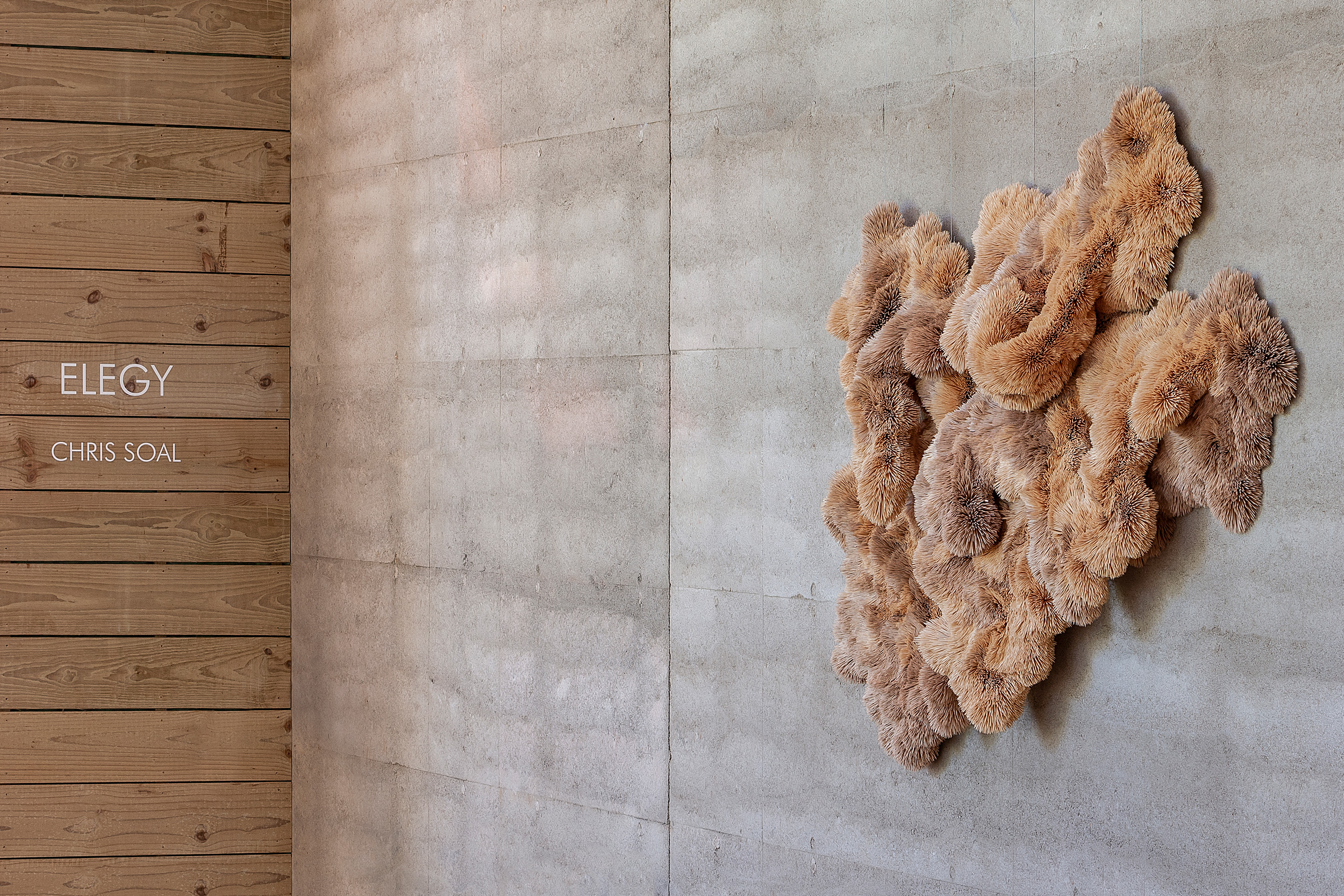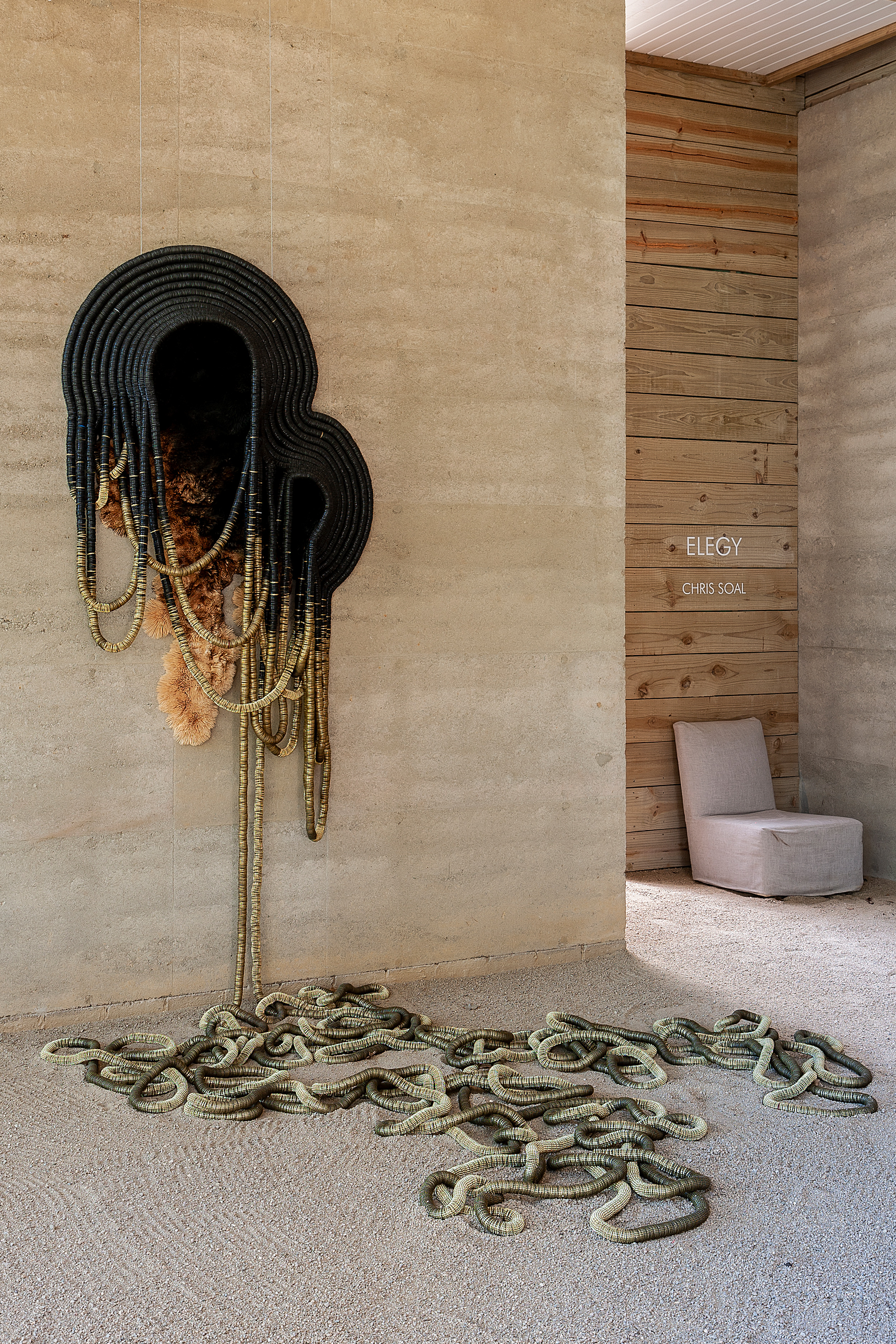In conversation with Chris Soal
AN INTERVIEW BY PHOKENG SETAI

With or without you, Requiem, Paniki | 2021 | Elegy Exhibition
So maybe I’ll start with something you’ve already spoken
about in other interviews. Let’s go with “As below, so above”
(2021). Looking back, what are some of your reflections on
it?
Looking back, I really felt like that show was maybe my most consolidated presentation yet. It felt like I brought together the things that have most compelled me over the years, and I was able to do so at a level that was of the highest quality, both in terms of form, in the way my ideas were refined and cohesive, and the technical quality of the work. The timing was really beneficial for me as well. Covid and 2020 benefited me in a paradoxical way, a reprieve from everyday life, as well as a break from the pressures of deadlines, and from art-world things like art fairs and international exhibitions, endlessly repeating back to back to back. It gave me a bit of space to focus— really focus. So that’s why, looking back, I have nothing but contentment for the show. What I really liked about that show was how I intended to treat the show almost like a survey of my ideas and yet all of a sudden there was this breakthrough into new territory with the bottle top works, that happened as a result of just sticking with something and pushing it and keeping my eyes open as to what new avenues arose. So I was very excited about that. How after years of noticing the serpentine/ intestinal-like forms the threaded caps made on the studio floor, to finally incorporating that observation into a work, that opened up a new branch of inquiry for me in that material. It was interesting then that I’ve just said I treated that show almost like a little survey, which I think, traditionally you think about surveys as something that you look back on and yet that piece, “As below, so above”, has very much guided the trajectory of many new works moving forward.
So
it almost functioned as a prospective, so to speak?
Yes, I like that—not a retrospective but a prospective, right? I find it beautiful and probably because I’m still a young artist, there’s many things that are surprising to me about things that maybe artists in the later stages of their careers would just be like, “yeah, that’s just standard procedure.” For example, the fact that I can be working with something for as long as I’ve been working with it and yet still it is giving me new things, you know, like it’s still breathing. There is more to something than we will ever know without spending sustained time with it. I guess the same could be said about everything in life, especially relationships. There’s always more to someone than you’ll ever know.
Staying with that show because I remember leaving being inspired by you, for many reasons—obviously, the work itself and just seeing your ambition and producing that kind of show. Then there’s looking at what you did on a more micro scale—how do you engage and interact with material? I would like you to, in the same vein, reflect on ELEGY, because ELEGY was up during the same period?
Elegy opened just before the “As below, so above” show ended. I had intended them to operate as sibling shows, or as two chapters of the same story.
There are a couple of takeaways that come to mind— firstly, it was so refreshing to have it after “As below, so above” because the show at WhatIfTheWorld was very ‘white cube’– like. It was a large scale show that had a very considered composition. I was very conscious of the scale of the works, the way some of my pieces occupied and infiltrated space in the gallery; and the way in which I was moving the viewer through the gallery, those were very considered gestures. ELEGY was a refreshing follow-on because it was such a different encounter with the work where the exhibition was almost submerged in conversation within nature itself. So, it was incredible to see how well the pieces fitted within the landscape of Nirox.
For me, the kind of artwork you make and the bodies of work you produce speak to your ambition as an artist, because that’s what you need to do with ideas—you have to believe in your ideas and push them as far as possible. So I was really impressed by them, especially how the toothpicks also reemerged as these indents in the pillars. So, ‘repurposing’ is maybe not the right word to use, but rather ‘bringing back’ material that has been quite important to your practice in the last three years or so.
I love that. It’s actually interesting, because those concrete columns in the gallery, “All That We can’t Leave Behind (2021) are constantly stimulating me. It’s almost as if I was saying “okay, you are familiar with my toothpick work as toothpicks. Maybe I can make you reconsider even your very familiarity with that object through their absence.” So it was an important moment for me to realise that a lot of my work, I think, is about presence and absence, and then not only the presence of the work but also becoming aware of your physical presence in the space of the work. For me there’s a central investigation of bodies and presence, and then thinking of the opposite, how absence can be a trigger as well—a trigger that can provoke contemplation and consideration.

While speaking about ELEGY, the notion of ‘belonging’
came to mind. Societal constructions of belonging are
integral to understanding phenomenology as a conceptual
paradigm. Alongside the concept of belonging, the ideas of
intentionality, consciousness and lived experience feature
quite critically in the paradigm. I want to ask you, Chris—
are you intentional about what kind of affect you want the
viewer to experience from your work?
Yes, I think what happens with me is that I have an encounter with material in a certain way that plants a seed in my consciousness. Another way of thinking about it is that the encounter makes me falter, just for a second. It’s almost like I’m in the rhythm of daily life, but then all of a sudden, there’s a misstep in my rhythm. It could be a minor misstep? It could be a major misstep? That’s the starting point for the bottle- top works. I’m fiddling with beer caps in taverns, drinking with friends from university, bending the caps in half and looking at them and thinking of cowrie shells. With the toothpicks it started with the photograph I took of a box of toothpicks forming a spiral, like a beautiful sunflower pattern, what we know to be the Fibonacci Spiral formula. I usually have an intention or an agenda for what I want the material to do but the material usually ends up doing something different. It is usually in that moment of the material revealing its own agency, where the generative opening resides.
I’m interested in how you arrive at phenomenology as a lens
to understand your work and practice?
I was making my work and then I encountered it. One of the reasons why I’ve really gravitated towards it is because I felt like it affirmed everything that I was already experiencing in the world or in the way in which I navigate the world as an individual, and in the way in which I saw my work materialising. I can’t deny the body. I can’t reduce myself to an intellect—my body is the way I move throug the world. I guess that’s why I found myself in sculpture because I respond to things, and my way of accessing things is through my body. Everything that I kept reading about phenomenology kept affirming and grounding me— encouraging me to push forward. I was recently reading All Art is Ecological from a contemporary phenomenologist (of sorts) Timothy Morton. I’m reading this text and the word ‘oscillation’ just sticks with me and I go look at definitions of the word and like the etymology of the word. The word oscillation would be used to describe the momentum of a pendulum. I realised that this work perfectly captured the movement of the viewer around my spiral bottle top disks. Oscillation can even further describe the way in whic something moves around a fixed point, and that’s exactly what a spiral does.

The notions of phenomenology, embodiment and sustained
studio practice are very integral to the emergence of your
work. How would you devise a link between these three
points?
Phenomenology has in ways helped me become more aware of myself, more attentive to space and my relationship to it, and to my interactions with materials and my surroundings. As I get older I increasingly see evidence of my early childhood experience manifested in my work. I am a Jozi [Johannesburg] boy. We’re having this conversation in Cape Town, having been living here for nine months. However, between the ages of 18 months and five years old I was living in Port Shepstone, in KwaZulu-Natal, so a lot of time was spent on the beach as a young, impressionable child exploring. It’s an environment that is very physically engaging—everything about the beach is tactile: the texture of the sand, slipperiness of the rocks, the feeling of water, the smells, the sounds, it’s a very embodied experience. A common comment on my work is how you can link a lot of the forms in my work to oceanic forms and I’m thinking here even of the bottle tops in how they read as cowrie shells when bent, and the way they become worm-like ocean coral forms. The coral or sponge reference is also strong with the toothpick works. And then, even the concrete negative forms become almost like dead coral, like dry coral reefs, or some sort of rock outcrop. It’s interesting when I observe how my work seems to gravitate towards certain tendencies that are intertwined with my own lived experience.
Absolutely. How do you approach the function of scale in
your work?
I think it begins with the self. As a tall, physically large and athletic person I guess that positions me in a particular way to the size of things in the world around me. This brings us back to thinking about embodiment. I often ask myself how I want to feel in front of something, what sort of affect it might have on me, the primary viewer. I think scale is about presence. There is a certain presence inherent to things, and I think that an artist’s job is finding the right conditions for the encounter between viewer and artwork. That’s why I don’t directly associate scale with size—something can be small but dominate the whole room, and something can fill an entire space but disappear into the background.
How would you say your lived-experience and your sense
of embodiment inform your studio practice?
Studio practice is about a place and about a particular type of attitude in that place. When I’m outside the space, there’s suddenly the absence of those pressures or those expectations. This allows me to think in new ways, so that’s why I’ve said time in the studio is as important as time out of the studio. That’s why sometimes I need to refuse myself availability to my team, and to people that are expecting things from me. I like going back to the allegory that I’ve often used, the idea of a water well as an expression of how I think about my practice. I think about it allegorically, like how the rain has to fall and it has to seep through all the sediments before it can form part of the water table. The well is the access to that which gets drawn up to the surface for someone to utilise. There’s a sense of time present in the manifesting of ideas into work, a period of sowing leading into a period of reaping. I think about how I took that photo of the toothpicks, but only two years later did my first work with that material. This is almost a way in which the idea seeps through the filtration system of our consciousness, whethe it’s bouncing between the guts and the brain or whatever, it takes time before it settles in a place where it can become accessible.
How do you come up with the titles to your works?
I use titles in almost the same way that I use materials: I collect them. Words and objects function differently so I spend a lot of time thinking about the relationship between the title and the work. Sometimes across a body of work you can see my titles as breadcrumbs bringing you nearer to my thinking around an object or concept. Other times titles are playful and offer a meander off the pathway, and other times they’re complete red herrings, designed to contrast or playfully evade interpretation. There are some titles that will work specifically for something in the same way that I know certain works need a specific thing either to work structurally or in their process.
So you work with discarded objects, and I guess there’s
a sustainable quality or element to that kind of practice—
you use them, repurpose them and you create artworks
with them. How would you situate your work or even your
practice alongside ecological concerns of our time such as
the Anthropocene?
So I think the starting point is not addressing ecological concerns for me, that comes through the process and in the outcome, and through the presence of these mass produced hyper-available objects. I think the reason I use the things I use is because I’ve had so much contact with them. Speaking about the body and tactility, touching this thing for as many times as I’ve touched it has left an impression on me, not only physically but also psychologically and conceptually and so that’s manifested back into my work. The second thing is about what I have on hand—like, what can be economically accessible to me. I think the most ecologically potent comments that my work makes is in the form that it takes—it’s interesting that there’s almost an un-engineering that happens. I use mass produced toothpicks, which were originally birch and bamboo trees, and through my process they return to an organic form.

I think that’s partly the nature of
things in the world—the way
gravity pulls toothpicks down,
the viscosity of the glue also,
and how when amassed they
support one another—there’s a
very practical reality to them.
I’ve really enjoyed the way in which
these toothpickworks start to
become like pelts and animal skins,
and I think the way in which I’ve
displayedthem on the wall is how
hunting trophies are presented.
These works start to point to our
paradoxical domination of, and
dependence on nature.
As Timothy Morton points out,
empathy is one of the greatest
tools we have in engaging with
the ecological situation of our
present.
Intuitively I’ve always pursued that,
even from early works such as
“Climb into someone else’s skin and
walk around in it” (2018).
Tell me about how your spatio-temporal relationship to the
lived environment manifests in your work?
I think I can tie in “Relic” (2019-2021) to this question, in
the way in which I almost see these as totems of a future possibility, but having materialised in the present. In the Catholic tradition ‘a relic’ refers to the remains and the bones of a saint, but specifically in the way in which something from the past becomes celebrated. An object from the past becoming sanctified and venerated. My work is in part about taking these insignificant materials and through the way they are presented to a viewer, transforming the materials into matters of new consideration and value through their encounter with it. And there’s “Spolia” (2022), a writhing beer bottle top work, which refers to how the remains of the past become incorporated into the present. Here I’m thinking with the materials of our contemporary moment, but also contemplating the past and the future.
How do you see your practice evolving or developing or
going in the coming future?
In the short term, I want to consolidate it. That is essentially what I’m trying to do here with these conversations, with the essays, with the bringing together of these bodies of work over the last period of years and considering my core concerns and motivations. I think there’s much left to explore with what I have currently worked with, and as I mentioned regarding a sustained practice, time and consideration given to something really do reveal possibilities initially unseen.
So I plan to continue working and watching and allowing the work to develop. Simultaneously I’ll continue to bring in the new, to place myself in new spaces, to expand my world and my worldview, and to continually allow for new avenues of engagement. But there may also come a moment in the future where I say ‘I’ve finished—this body of work is done,’ and I need to exit that chapter to step into a new project of pursuit.
You could even take an architectural turn, who knows?
Completely brother, I’d love to and I think that one of the things which has attracted me to art from the very beginning is realising that the art world is completely open and the trajectory of one’s practice is not limited or linear.
I think those are the kinds of liberties that playing with
ideas can offer you.
Something I’m also continuously doing is “stealing” from
other artists, as I have often read things that other artists
have done or said that’s given me a sense of permission.
It’s made me feel there’s a realm of possibility and it is
an area of acceptance in that possibility, and I guess it’s something to even dive into why I feel I need to be allowed to do something. Not that I’m waiting for someone to allow me to do something before I do it. But there’s something about the way fear plays itself out in the creative process that to hear that someone else has done something gives you “precedent” for doing, and I think it’s interesting to use that legal term “precedent.”
So now, with the physical environment of Joburg being an
inspiration for you—the signs and symbols you see when
living in Joburg—for example, the concrete, the gold, the
hustle and bustle. You know whatever the urban Joburg
offers, it’s almost like a muse in your work. How do you
interpolate the inspiration that Joburg gives you into other
environments you inhabit?
That’s why concrete seems to have been something that has stayed with me throughout my practice. There is something about how varied in texture concrete can be, how it captures the impressions of what casts it, and how over time and in contact with organic growth it chips and cracks and breaks that’s always caught my eye. It’s been a handy material as I feel like Joburg has a metaphorical rough edge to it. But also I guess all the materials that I use are very intrinsically present in Johannesburg, like those present in my earliest pieces; barbed wire, broken glass, rebar, concrete, beer bottle tops, electric fencing cable, all of them are immediately accessible within an environment. Interestingly enough, I think the common thread between all of these disparate materials is that they’re present but often unrecognised or un-considered in that moment, like they form part of the kind of backdrop, you know, they fade into the periphery. They are very seldom the focal point.
But to directly answer your question, I spent time in Knysna on a residency in the first year out of university, where I developed the body of work with toothpicks. I distinctly remember returning to Joburg and being confronted with this questioning feeling of how this work which appears soft and fluffy could exist in a place as fast paced and edgy as Joburg. It was then that I made my first concrete and toothpick piece, juxtaposing the two materials and really being amazed by the outcome.
I’m interested in how as humans we make meaning of things
around us. Certain ideas will come to you and there is a
meaning-making that will take place. Let’s take the same
thinking and think about art-making and how material is a
catalyst that makes or gives meaning to the encounter.
We share an affinity with materials, right? Because there’s something we can grasp, there is something that’s made up chemically or physically, of not too dissimilar things from ourselves, so there’s always a relationship through material to the self. That’s one of the reasons why I use material to “communicate” instead of speaking or writing, which are maybe more immaterial, concept-based things. For me there’s something about the tactility of that thing that allows us to begin an encounter that slips past our conscious barriers and allows us to have an experience we otherwise might not have allowed ourselves to comprehend. The straight answer is that I begin from my own point of departure with the material. In terms of intersubjectivity or co-constructed meaning, it definitely plays into how I am conscious of the effect on others and I am like looking for that and I’m thinking about that and I’m watching people as they’re engaging with my work. I’m listening to what the feedback is in the studio, but I’m also not dismissing my personal point of departure either, you know. These are points of tension which I’m leaning into, where things are being held simultaneously in the interpretation and in the intention. The beauty for me in working within abstraction
is its “slipperiness,” which allows the work to become many things while avoiding being fixed by any one.
Your artistic practice seems to revolve around continuums,
let’s for a moment substitute the word ‘continuum’ with
‘oscillation’. You mentioned oscillations and I think of a
continuum operating in the same way. Would you say that
this is a fair assessment?
There are these common and repeated motifs and moments and nodal points right within the work, but they’re at different points in time and in development. I found that kind of interesting and I think you’re right, it does operate in a continuum because I put faith in the process, I’ve trusted the process, because I’ve seen that the process—the time, the dedication and consistency—reveal things beyond myself. Going on the journey of the work is what reveals the way to me. I would almost say the journey is always in a mist so I can only ever see five feet in front of me, but when I’ve walked five feet I can see five feet more and more. And that’s kind of what I was referring to earlier, where I say I follow the works as they lead me on. This process of oscillating or revolving around continuums is inherent to the creative process and maybe even to life itself. I think of the way this is reflected both in the downward spiraling journey of Inferno and the spheres of Paradiso in Dante’s work.

You are moving alongside these oscillations and
continuums and allowing yourself to be led by them. Thank
you very much for your time, Chris.
Thank you, brother.
- Phokeng Setai, In conversation with Chris Soal